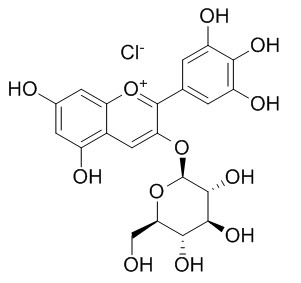Delphinidin-3-O-glucoside chloride
Delphinidin-3-O-glucoside chloride has antioxidant activity.
Inquire / Order:
manager@chemfaces.com
Technical Inquiries:
service@chemfaces.com
Tel:
+86-27-84237783
Fax:
+86-27-84254680
Address:
1 Building, No. 83, CheCheng Rd., Wuhan Economic and Technological Development Zone, Wuhan, Hubei 430056, PRC
Providing storage is as stated on the product vial and the vial is kept tightly sealed, the product can be stored for up to
24 months(2-8C).
Wherever possible, you should prepare and use solutions on the same day. However, if you need to make up stock solutions in advance, we recommend that you store the solution as aliquots in tightly sealed vials at -20C. Generally, these will be useable for up to two weeks. Before use, and prior to opening the vial we recommend that you allow your product to equilibrate to room temperature for at least 1 hour.
Need more advice on solubility, usage and handling? Please email to: service@chemfaces.com
The packaging of the product may have turned upside down during transportation, resulting in the natural compounds adhering to the neck or cap of the vial. take the vial out of its packaging and gently shake to let the compounds fall to the bottom of the vial. for liquid products, centrifuge at 200-500 RPM to gather the liquid at the bottom of the vial. try to avoid loss or contamination during handling.
Plants (Basel).2024, 13(6):868.
Journal of Food Quality2022, P:13, 6256310.
Naunyn Schmiedebergs Arch Pharmacol.2024, 03148-x.
Molecules.2019, 24(10):E1926
Biomolecules.2022, 12(12):1754.
Mol Neurobiol.2022, 02873-9.
Asian J Beauty Cosmetol2016, 14(3):249-257
J Pharmacol Sci.2021, 147(2):184-191.
Nutrients.2024, 16(16):2612.
Front Pharmacol.2016, 7:460
Related and Featured Products
Sci Rep . 2015 Mar 11;5:8996.
Bilberry extract (Antho 50) selectively induces redox-sensitive caspase 3-related apoptosis in chronic lymphocytic leukemia cells by targeting the Bcl-2/Bad pathway[Pubmed:
25757575]
Abstract
Defect in apoptosis has been implicated as a major cause of resistance to chemotherapy observed in B cell chronic lymphocytic leukaemia (B CLL). This study evaluated the pro-apoptotic effect of an anthocyanin-rich dietary bilberry extract (Antho 50) on B CLL cells from 30 patients and on peripheral blood mononuclear cells (PBMCs) from healthy subjects, and determined the underlying mechanism. Antho 50 induced concentration- and time-dependent pro-apoptotic effects in B CLL cells but little or no effect in PBMCs. Among the main phenolic compounds of the bilberry extract, delphinidin-3-O-glucoside and delphinidin-3-O-rutinoside induced a pro-apoptotic effect. Antho 50-induced apoptosis is associated with activation of caspase 3, down-regulation of UHRF1, a rapid dephosphorylation of Akt and Bad, and down-regulation of Bcl-2. Antho 50 significantly induced PEG-catalase-sensitive formation of reactive oxygen species in B CLL cells. PEG-catalase prevented the Antho 50-induced induction of apoptosis and related signaling. The present findings indicate that Antho 50 exhibits strong pro-apoptotic activity through redox-sensitive caspase 3 activation-related mechanism in B CLL cells involving dysregulation of the Bad/Bcl-2 pathway. This activity of Antho 50 involves the glucoside and rutinoside derivatives of delphinidin. They further suggest that Antho 50 has chemotherapeutic potential by targeting selectively B CLL cells.
Electroanalysis, 2010, 19(17):1779-1786.
Redox Behavior of Anthocyanins Present in Vitis vinifera L.[Reference:
WebLink]
Voltammetric techniques were employed to study the electrochemical behavior of several anthocyanins.
METHODS AND RESULTS:
The redox behavior of anthocyanins with the same basic structure, the influence of glycosylation on the redox behavior of anthocyanins derived from different anthocyanidins, and the influence of methoxylation were investigated. The anthocyanins used in this study were malvidin-3- O -glucoside chloride, malvidin-3,5-di- O -glucoside chloride, cyanidin-3- O -glucoside chloride, cyanidin-3,5-di- O -glucoside chloride, peonidin-3- O -glucoside chloride, Delphinidin-3-O-glucoside chloride and the anthocyanidin petunidin chloride, all of them present in Vitis vinifera L.
CONCLUSIONS:
All hydroxyl groups of the anthocyanins can be electrochemically oxidized and the anthocyanins studied revealed a complex and pH dependent oxidation process, with the occurrence of adsorption and of oxidation products blocking the electrode surface.



